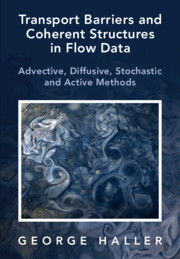Crossref Citations
This Book has been
cited by the following publications. This list is generated based on data provided by Crossref.
Rempel, Erico L.
Chian, Abraham C.-L.
de S. A. Silva, Suzana
Fedun, Viktor
Verth, Gary
Miranda, Rodrigo A.
and
Gošić, Milan
2023.
Lagrangian coherent structures in space plasmas.
Reviews of Modern Plasma Physics,
Vol. 7,
Issue. 1,
Li, Mingwu
Kaszás, Bálint
and
Haller, George
2024.
Variational construction of tubular and toroidal streamsurfaces for flow visualization.
Proceedings of the Royal Society A: Mathematical, Physical and Engineering Sciences,
Vol. 480,
Issue. 2285,
Kaszás, Bálint
and
Haller, George
2024.
Capturing the edge of chaos as a spectral submanifold in pipe flows.
Journal of Fluid Mechanics,
Vol. 979,
Issue. ,
Harms, Tanner D.
Brunton, Steven L.
and
McKeon, Beverley J.
2024.
Lagrangian gradient regression for the detection of coherent structures from sparse trajectory data.
Royal Society Open Science,
Vol. 11,
Issue. 10,
Hiraiwa, Naoki
Bando, Mai
Nisoli, Isaia
and
Sato, Yuzuru
2024.
Designing robust trajectories by lobe dynamics in low-dimensional Hamiltonian systems.
Physical Review Research,
Vol. 6,
Issue. 2,
Aksamit, Nikolas
Katurji, Marwan
and
Zhang, Jiawei
2024.
Understanding Coherent Turbulence and the Roll‐Cell Transition With Lagrangian Coherent Structures and Frame‐Indifferent Fluxes.
Journal of Geophysical Research: Atmospheres,
Vol. 129,
Issue. 18,
Harlander, Uwe
Kurgansky, Michael V.
Speer, Kevin
and
Vincze, Miklos
2024.
Baroclinic instability from an experimental perspective.
Comptes Rendus. Physique,
Vol. 25,
Issue. S3,
p.
1.
Watanabe, Tomoaki
Abreu, Hugo
Nagata, Koji
and
da Silva, Carlos B.
2025.
Small-scale shear layers in isotropic turbulence of viscoelastic fluids.
Journal of Fluid Mechanics,
Vol. 1005,
Issue. ,



